Ehlers Danlos syndrome in dogs (Dermatosparaxis,Cutaneous Asthenia)
EHLERS DANLOS SYNDROME IN DOGS (DERMATOSPARAXIS)
- The hallmark of this syndrome is the very stretchy, fragile skin
[ad name=”Tweet”]
Ehlers Danlos syndrome in dogs, also known as Dermatosparaxis is a rare syndrome where there is a genetic problem with the formation of connective tissue in the body of the dog. Connective tissue is found everywhere in the body and is exactly what its name says it is – tissue that connects things together. If the connective tissue is faulty, then things that should be joined together tightly in the normal body suddenly have weak and very elastic connections. This leads to unstable joints and legs as well as very stretchy skin – the external hallmarks of Ehlers Danlos syndrome in dogs.
The connective tissue affected is known as collagen and there is a deficiency of collagen in these dogs as well as alterations in the size of collagen fibres and broken collagen fibres. (1) A biochemical defect in collagen production or breakdown occurs. The enzyme known as Collagenase, functions to normally breakdown old collagen in animals but in these dogs, levels were 2.5 times those of a normal dog. (2)
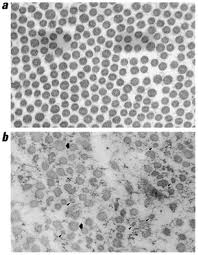
There can be internal problems as well, as connective tissue is also very important in the veins, arteries and heart valves. Severely affected puppies usually will not survive, but puppies with a mild form will generally survive until adulthood.
WHAT ARE THE SIGNS OF EHLERS-DANLOS SYNDROME IN DOGS
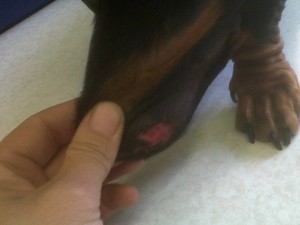
- Skin can be stretched very far compared to normal dogs as the tissue connecting the skin to the underlying muscle is malformed and the connective tissue joining cell to cell also is very elastic.
- The skin tears very easily. Most of these dogs keep on ‘getting injuries’ like cuts or open wounds at home. Most people assume they merely own an accident prone dog at first, but when the vet bills for regular stitch ups are occurring a few times a month, most people will question of there is a problem with their pet’s skin.
- The joints in the legs are very lax and can be twisted or bent without discomfort far further than they should be able to.
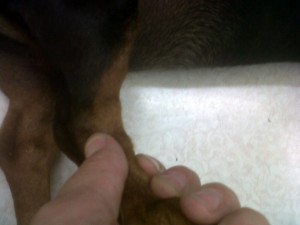
- Dogs develop fine white scars all over their bodies where the skin keeps getting torn and heals badly.
- Dogs may have eye problems such as cataracts and poor accommodation of the lens due to faulty connective tissue within the eye.
- The hair coat can be fine and dry. (1)
- Severely affected dogs can develop a fatal split in the skin starting on the tail and progressing up the body as the skin on the body literally splits ‘in half. ‘ These will not heal and dogs that develop this will have to unfortunately be put to sleep.
- Many moderately to severely affected dogs will live for 2-3 years at most before the problems become too severe. Mildly affected dogs without joint problems can live normal lives if their owners take care with their skin.
- It is rare to find skin, joint and eye abnormalities in the same animal. (1)
- The skin may be hypersensitive.DIAGNOSIS OF EHLERS DANLOS SYNDROME
-
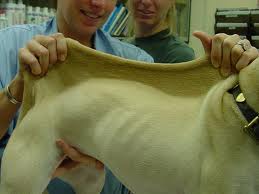
Testing the skin to measure if a dog may have Ehlers-Danlos syndrome Your vet may suspect your pet has Ehlers Danlos syndrome and perform a skin extensibility index test which is done by measuring how far a fold of skin can be pulled upward above the spine. This is then compared to the distance between the back of the head and the base of the tail and a value of more than 14.5% in the dogs indicates he or she could be suffering from Ehlers Danlos syndrome.To diagnose the condition definitively, your vet will recommend skin biopsies which are tiny pieces of skin removed under sedation and analyzed in a laboratory by a pathologist.
WHAT CAN I DO TO KEEP MY AFFECTED PET HEALTHY?
Because the skin tears so easily and joints are hyperflexible, owners should take care that they don’t have any sharp objects or corners in the houses or gardens that the dog can tear the skin. These dogs should preferably be house dogs and too much exercise should be avoided. Any wounds that occur need to stitched closed and not left to heal on their won as the skin is unable to do that without forming a scar.
PREVENTION OF EHLERS DANLOS SYNDROME IN DOGS
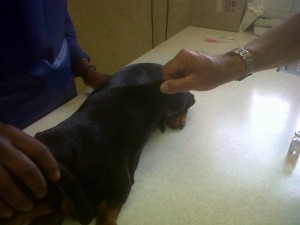
Very stretchy skin on the back
- These dogs should never be allowed to breed as it is a dominant genetic problem.
The following breeds are known to be affected by cutaneous asthenia:
Boxer, Dachshund, English Springer Spaniel, German Shepherd, Greyhound, Pembroke Welsh Corgi, St.Bernard, Weimeraner, Beagle, Australian Kelpie, English and Irish Setters, Keeshond, Manshester Terrier, Soft Coated Wheaten Terrier, Minature Schnauzer.REFERENCES1. http://www.ncbi.nlm.nih.gov/pmc/articles/PMC1480711/?page 1 and 22. - 2.http://www.cvhs.okstate.edu/index.php?option=com_content&view=article&id=219:ehlers-danlos-syndrome-what-is-it-and-is-there-a-cure&catid=27:small-animal-questions&Itemid=3153.
- 3. www.hmg.oxfordjournals.org
- 4. www.findmeacure.com

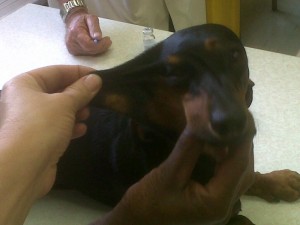
Leave a Reply
You must be logged in to post a comment.